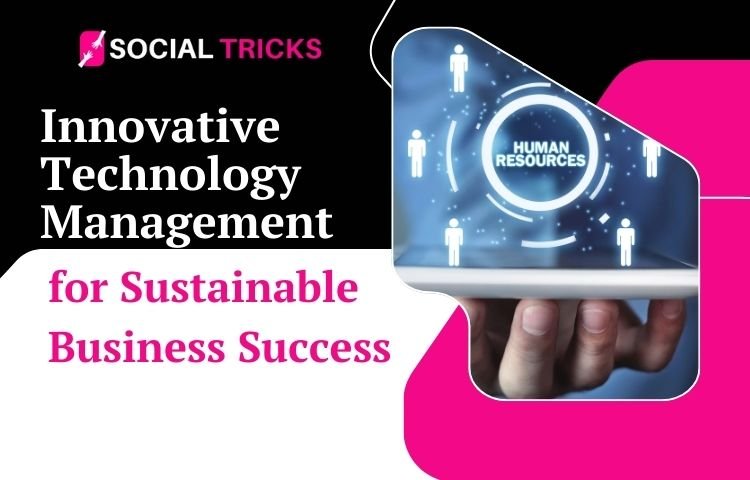In the ever-accelerating dynamics around the world, they have to innovate from the perspective of technology management to keep themselves forward and take their successes not with as many hits. Technology is no more of a concept as the backbone for sustainability and a competitive edge.
Why Is Technology’s Management Important In The Context of Business?
That is the requirement for the management of Technology:
- Increased Efficiency: Technology helps simplify processes while reducing the labor required for manual work.
- Boosted Productivity: Automation and attention to worker time spent on repetitive activities allow high-quality time spent in creative pursuits.
- Cost Savings: Technologies can reduce operational expenditure and make resource use more productive.
- Attainment of Sustainability Goals: Be it greening through some of the most technosocial practices.
Key Components of Technology Management
Optimal management of technology can be achieved by taking into account these few critical actions:
- Strategic Planning: Relevant technology strategies must be correlated with organizational objectives.
- Innovation Culture: A learning organization encourages creativity and broad minds to foster innovation.
- Resource Allocation: If any limitation of financial source exists, it should distribute resources to tools, training and infrastructural development.
- This is The Purpose of Data-Driven Decisions: In using data analytics and data-generated insights, this helps makes rationalized decisions.
- Adaptability: Lastly, it helps for your transformation in new technologies to be bright.
Technology for Sustainable Development
Sustainability is becoming a paramount issue for businesses coming worldwide. The manner technology helps the sustainable strategy can illustrate.
- Efficiency in Energy: A smart environment limits energy use.
- Savings on Waste: Much of the waste from new production systems is being reduced.
- Digital Revolution: This paperless revolution saves much of the world’s forests.
- Supply Chain and Data Optimization: Forwarding the supply chain enables real-time tracking to save both on transportation issues and emissions.
Real-World Statistics concerning Technology and Sustainability
Experiences from about 40% of savings in energy are achieved by companies that digitalize their transformations.
AI and automation achieve 20-30% higher efficiency.
Over 75% of the customers favor environmentally responsible businesses.
By 2030, green technology is projected to account for over $10 trillion in economic value globally.
Examples of Innovative Technology Management
Tesla:
Tesla’s battery tech in conjunction with electric vehicles help reduce carbon emissions.
These remote wireless patches through software updates optimize their vehicle performance, thereby saving on other resources.
Amazon:
AI robotic systems are employed by Amazon throughout its warehouse to enhance efficiency.
Many Amazon fulfillment centers are powered by renewable energy.
Unilever:
Unilever is working toward fostering blockchain capable of maintaining traceability of its supply chains in order to ensure ethical practices.
A corporate-structured Sustainable Living Plan integrates technology to render zero waste a possibility.
Initiatives to Ensure Effective Technology Management in Business
Assess Needs:
Identify business challenges and how technology can address them.
- Set Clear Objectives: – Defining goals referring to implementation of new technologies.
- Investments in Specific Technical Training: – Enhance, upgrading employees of the information needed to make effective usage thereof.
- Selectable Options: – Adopt technologies capable of growing with the business.
- Regularly Monitoring and Proving: – Monitor performance through regular evaluation of data, hence proactively correct any errors in the process.
Technological Management Issues
Technology is a valuable asset for businesses, but the following are perceived as the main challenges:
- High-To-Initiation-Costs: Technologies are usually costly and short of funds for the initial investment.
- Resistance: Employees and stakeholders may resist changing management strategies.
- Risk of Cybersecurity: Smooth running of businesses online are fraught with risks of data theft and hacking.
- Skill Gaps: Unfortunately, ignorance impedes effective use of the best managers.
Solution to Overcome Challenges
Consider the following as effective strategies to deal with common challenges:
- Budget Planning: Start small and steadily grow.
- Change Management: Provide clear value of strategic investments in any particular area and let team members participate in decision-making.
- Strong Security: Invest heavily in cybersecurity simple solutions.
- Continuous Learning: Training, upskilling, and satellite workshops are necessary more frequently during the year.
Future of Technological Management
- AI: – Complex tasks are automated and actionable insights of technology always fed addresses at the heart of AI customization.
- IIoT: – Connected devices serving operations with informed decision-making and operation improvements.
- Green Technology: – We see an era dominated by renewable resources of energy, solar power, and organic construction.
- Blockchain: – Blockchain’s capability is transparency and security all the way through complex transactions and supply chains.
- 5G: – Better internet speed would increase the remaining authentic communication and the remote working capacity.
Award of Implementing Innovative Technology Management
- Enhanced Customer Satisfaction: Personalized services and responsiveness could be new for their customers’ endearment.
- Competitive Edge: Staying ahead through technology would shoot the company’s chances to a position of the market.
- Sustainable Growth: We are constantly working to reduce the negative impacts we have on our planet.
Conclusion
Successful businesses entrepreneurship is technology management. Companies that innovate through technology now experience better productivity, reduced expenses of survival, and even least ecological devastation. The choice of being with AI, IoT, or a green environment can now be presented as long as they strategically come together as an integrated mechanism. Like never before other than through meticulous planning and follow-through side by side, the guaranteed edge towards growth will offer too.


